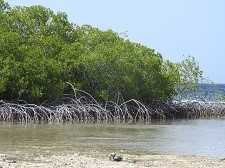On July 26 we celebrate International Mangrove day. In Aruba, we know four types of mangroves protected by the National decree protection of indigenous flora and fauna (AB 2017 no.48).
These mangrove trees are the Black mangrove (Avecinnia germinans), Fofoti (Conocarpus erecto), Red mangrove (Rizophora mangle), and the White mangrove (Laguncularia racemosa). The Department of Nature and Environment (DNM) is responsible for providing information about the importance of these ecosystems and the need to preserve and protect these mangroves.
Mangroves are essential for the survival of many other marine species and the protection of the shore. The root system anchors deeply in the bottom of the ocean and provides optimal protection against natural disasters. These roots are the perfect hiding place for small fish. They are also the breeding grounds for organisms that are on the lower scale of the food chain. In addition, the mangroves provide excellent habitats for birds.
There is often a strong smell when exploring the mangroves caused by falling leaves that decompose in the water. These rotting leaves also cause the water to look brown and the soil to be muddy.
Mangroves characteristics:
Mangroves need saltwater to survive. Mangroves grow on the shore, in bays, and in wetlands connected to the ocean. Each mangrove has its aspects and function in nature. There used to be many more mangroves on the reefs, but now they are more concentrated in Spaans Lagoen and Isla di Oro, which areas are protected.
Common characteristics of Mangroves:
- They all grow on the shore or in brackish water on the wetlands.
- They reproduce in two ways; the roots grow underwater and in the ground out of the water. They also reproduce by dropping their propagules into the water.
- They have white and white-beige flowers. They produce nectar.
- The roots are mainly submerged and anchored in the mud.
- They grow in the same ecological environment (plants, salt water, sun, and wind).
- They extract the salt from the ocean water using their roots and feed their leaves with the salt.
The mangroves contribute to our food supply. The roots contain an abundance of food for the crabs, limpets, and whelks. The mangrove trees also serve as breeding places and hideouts for fish and other smaller species, a.o. “Moli-moli”, Palulo (oysters), plankton, and Benthic-Algae. The algae indicate the presence of carbon in the mangroves’ ecosystem. Seagrass is full of marine life and is home to seahorses, starfish, little sea turtles, eels, and small fish. The seagrass is the “go-to” meal for sea turtles and starfish. These species grow in abundance between the mangrove’s roots. They grow where the sun shines through and are a good source of nutrition.
The mangroves are full of insects and a variety of other species. You’ll find spiders, beetles, and almost every other insect you can find at home. The spider webs catch butterflies and moths, beetles, flies, and mosquitos. You’ll also find reptiles like the Anolis Lineatus, Aruba Whiptail lizards, iguanas, house geckos, boa constrictor, and bats that are hanging off the branches. Local birds and shorebirds also frequent the mangroves. They use the mangroves as shelter to sleep in and rest. They often seek quiet and darker spots in nature as shelter.
The goal of the DNM is to raise awareness of the essential ecological, economic, and social values that the mangrove forests are for Aruba. The DNM is grateful to all NGOs that help focus on the importance of the mangroves, especially Stimaruba for their unconditional support, guidance, and contribution to this cause. Let’s not destroy the mangroves, as you are also destroying the habitats of thousands of species. Some people consider the mangroves as obstacles, blocking their ocean view, but these same mangroves can protect their property in case of natural disasters. Happy International Mangroves day 2021.




















